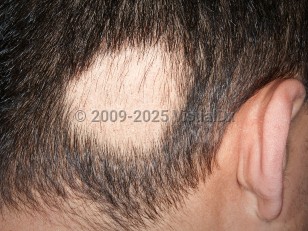Alopecia areata - Hair and Scalp
See also in: Overview,External and Internal Eye,Nail and Distal DigitAlerts and Notices
Important News & Links
Synopsis

Alopecia areata is seen equally in both sexes and in patients of all ages, races, and ethnicities. There is an increased incidence of alopecia areata in patients with Down syndrome as well as those with autoimmune diseases, most commonly thyroid disease. Patients with alopecia areata are also more likely to have atopy, and its presence is felt to be a poor prognostic indicator.
While medication-induced alopecia areata has been uncommon in the literature, there have been articles published reporting an association with some medications, including the TNF inhibitors adalimumab, etanercept, and infliximab. Other more recently described culprit agents include proton pump inhibitors and immune checkpoint inhibitors (CTLA-4, PD-1) that are used to treat malignancies. Alopecia areata following COVID-19 infection and vaccination has also been reported.
The course of alopecia areata is unpredictable, with wide variation in duration and extent of disease occurring from patient to patient. In most patients, hair will eventually spontaneously regrow, although recurrences are common. The condition is treatable but cannot be cured.
In one retrospective study of 321 patients, temporal area involvement was independently associated with worse prognosis (in addition to extent of hair loss).
A 2022 retrospective population-based study in Taiwan showed an increase in retinal diseases among 9909 patients with alopecia areata. The disease extent and prior steroid treatment were not commented on; further studies are needed to confirm an association.
Codes
L63.9 – Alopecia areata, unspecified
SNOMEDCT:
68225006 – Alopecia areata
Look For
Subscription Required
Diagnostic Pearls
Subscription Required
Differential Diagnosis & Pitfalls

Subscription Required
Best Tests
Subscription Required
Management Pearls
Subscription Required
Therapy
Subscription Required
Drug Reaction Data
Subscription Required
References
Subscription Required
Last Updated:02/01/2024
 Patient Information for Alopecia areata - Hair and Scalp
Patient Information for Alopecia areata - Hair and Scalp- Improve treatment compliance
- Reduce after-hours questions
- Increase patient engagement and satisfaction
- Written in clear, easy-to-understand language. No confusing jargon.
- Available in English and Spanish
- Print out or email directly to your patient


